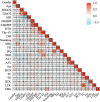A study on predicting the risk of coronary artery disease in OSAHS patients based on a four-variable screening tool potential predictive model and its correlation with the severity of coronary atherosclerosis
- PMID: 40656768
- PMCID: PMC12245809
- DOI: 10.3389/fcvm.2025.1602492
A study on predicting the risk of coronary artery disease in OSAHS patients based on a four-variable screening tool potential predictive model and its correlation with the severity of coronary atherosclerosis
Abstract
Objective: This study aims to evaluate the potential association between the four-variable screening tool (the 4 V) potential predictive model in predicting coronary artery disease (CAD) risk in patients with obstructive sleep apnea-hypopnea syndrome (OSAHS) and its correlation with the severity of coronary atherosclerosis, as measured by the Gensini scoring system.
Methods: 1197 OSAHS patients with suspected CAD who were hospitalized in the First Affiliated Hospital of Xinjiang Medical University between March 2020 and February 2024 were selected. The patients were submitted to coronary angiography or Coronary Computed Tomography Angiography (CCTA) examination to confirm the diagnosis. There were 423 cases in the OSAHS plus CAD group and 774 cases in the OSAHS group. LASSO regression analysis was carried out for screening potential influencing factors. Propensity score matching (PSM) was used to balance covariables between groups, and 293 cases were included per group in a 1:1 ratio. Univariable and multivariable logistic regression analyses were employed to evaluate parameters independently associated with CAD and construct a nomogram model.Receiver operating characteristic (ROC) curve analysis, Hosmer-Lemeshow test, calibration curve and decision curve (DCA) analyses were employed to assess its predictive value in CAD. A random forest machine learning algorithm was used to evaluate the importance of each risk factor. Pearson's or Spearman's correlation coefficients were employed to assess the strengths of associations among all variables and between predictors and Gensini scores, reflected in heat maps and chord diagrams, respectively.
Results: LASSO-logistic regression analysis revealed age (OR = 1.07, 95% CI: 1.05-1.1, P < 0.001), hypertension (OR = 1.29, 95% CI: 1.16-1.44, P < 0.001), AHI (OR = 1.02, 95% CI: 1.01-1.03, P = 0.007), and the 4 V (OR = 1.84, 95% CI: 1.21-2.79, P = 0.004) were independently associated with OSAHS plus CAD. The analysis of the ROC curve revealed that the combined utilization of the aforementioned predictors significantly enhances the potential predictive capability for patients with OSAHS developing CAD. The Hosmer-Lemeshow test, calibration curve, and DCA results indicate that potential predictive model based on the 4 V possesses significant clinical applicability in predicting OSAHS in conjunction with CAD. A comprehensive analysis utilizing the random forest machine learning algorithm demonstrated that the AHI exhibits the highest predictive value. Furthermore, the model's performance, as evaluated through out-of-bag error assessment, suggests robust efficacy. The correlation analysis results showed that the scores of the four-variable screening tool were positively correlated with the Gensini scores.
Conclusion: Age, hypertension, AHI, and the four-variable screening tool are independent risk factors for CAD in patients with OSAHS. The potential predictive model based on the 4 V is closely related to the prediction of CAD and its correlation with the severity of coronary atherosclerosis.
Keywords: association study; coronary artery disease; four-variable screening tool; obstructive sleep apnea hypopnea syndrome; prediction.
© 2025 Yao, Li, Chen, Qiu, Aimaiti and Maimaitimin.
Conflict of interest statement
The authors declare that the research was conducted in the absence of any commercial or financial relationships that could be construed as a potential conflict of interest.
Figures






Similar articles
-
Comparison of Two Modern Survival Prediction Tools, SORG-MLA and METSSS, in Patients With Symptomatic Long-bone Metastases Who Underwent Local Treatment With Surgery Followed by Radiotherapy and With Radiotherapy Alone.Clin Orthop Relat Res. 2024 Dec 1;482(12):2193-2208. doi: 10.1097/CORR.0000000000003185. Epub 2024 Jul 23. Clin Orthop Relat Res. 2024. PMID: 39051924
-
Interpretable machine learning analysis of immunoinflammatory biomarkers for predicting CHD among NAFLD patients.Cardiovasc Diabetol. 2025 Jul 3;24(1):263. doi: 10.1186/s12933-025-02818-1. Cardiovasc Diabetol. 2025. PMID: 40611098 Free PMC article.
-
Are Current Survival Prediction Tools Useful When Treating Subsequent Skeletal-related Events From Bone Metastases?Clin Orthop Relat Res. 2024 Sep 1;482(9):1710-1721. doi: 10.1097/CORR.0000000000003030. Epub 2024 Mar 22. Clin Orthop Relat Res. 2024. PMID: 38517402
-
Signs and symptoms to determine if a patient presenting in primary care or hospital outpatient settings has COVID-19.Cochrane Database Syst Rev. 2022 May 20;5(5):CD013665. doi: 10.1002/14651858.CD013665.pub3. Cochrane Database Syst Rev. 2022. PMID: 35593186 Free PMC article.
-
The effectiveness and cost-effectiveness of computed tomography screening for coronary artery disease: systematic review.Health Technol Assess. 2006 Oct;10(39):iii-iv, ix-x, 1-41. doi: 10.3310/hta10390. Health Technol Assess. 2006. PMID: 17018228
References
LinkOut - more resources
Full Text Sources
Miscellaneous

